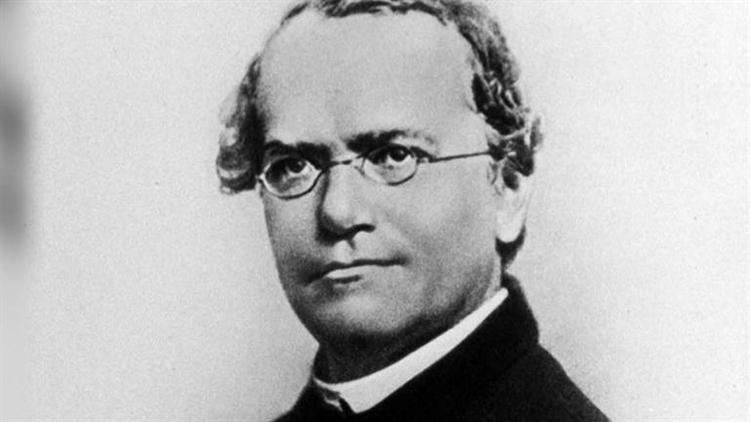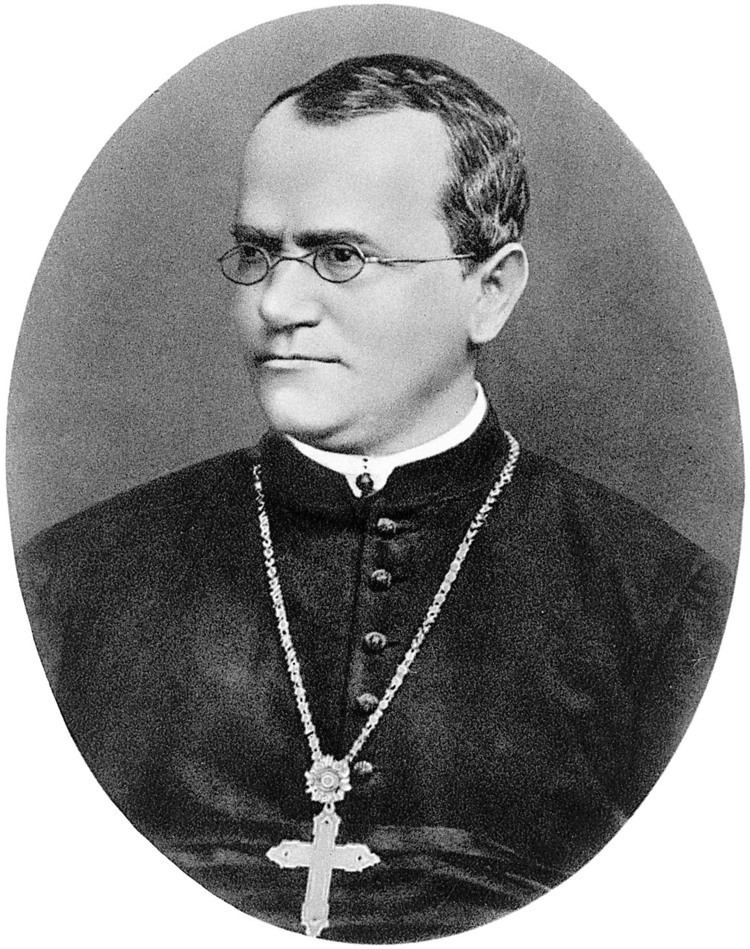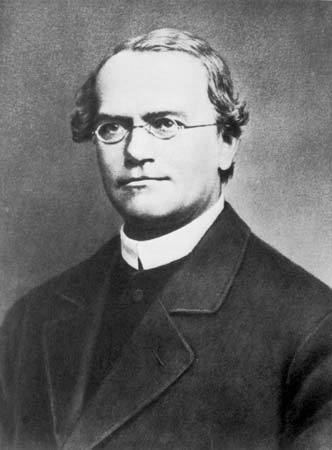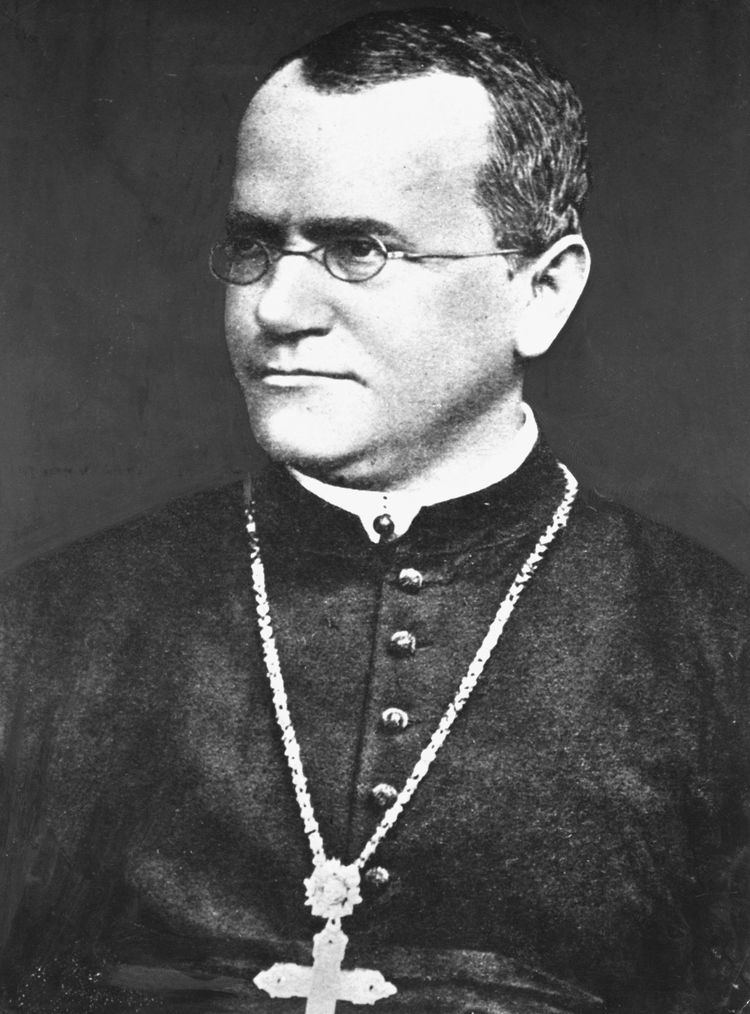Nationality Austrian Fields Genetics Role Scientist | Name Gregor Mendel | |
 | ||
Born Johann Mendel20 July 1822Heinzendorf bei Odrau, Austrian Empire (now Hyncice, Czech Republic) ( 1822-07-20 ) Alma mater University of OlomoucUniversity of Vienna Siblings Veronica Mendel, Theresia Mendel Parents Rosine Mendel, Anton Mendel Similar People Charles Darwin, Thomas Hunt Morgan, Louis Pasteur, James Watson, Hugo de Vries | ||
Gregor mendel mini biography
Gregor Johann Mendel (Czech: Řehoř Jan Mendel; 20 July 1822 – 6 January 1884) ( ) was a scientist, Augustinian friar and abbot of St. Thomas' Abbey in Brno, Margraviate of Moravia. Mendel was born in a German-speaking family in the Silesian part of the Austrian Empire (today's Czech Republic) and gained posthumous recognition as the founder of the modern science of genetics. Though farmers had known for millennia that crossbreeding of animals and plants could favor certain desirable traits, Mendel's pea plant experiments conducted between 1856 and 1863 established many of the rules of heredity, now referred to as the laws of Mendelian inheritance.
Contents
- Gregor mendel mini biography
- Greatest genetics discoveries gregor mendel mp4
- Life and career
- Experiments on plant hybridization
- A specific illustration Crossing tall and short plants
- Initial reception of Mendels work
- Other experiments
- Rediscovery of Mendels work
- The Mendelian Paradox
- References

Mendel worked with seven characteristics of pea plants: plant height, pod shape and color, seed shape and color, and flower position and color. Taking seed color as an example, Mendel showed that when a true-breeding yellow pea and a true-breeding green pea were cross-bred their offspring always produced yellow seeds. However, in the next generation, the green peas reappeared at a ratio of 1 green to 3 yellow. To explain this phenomenon, Mendel coined the terms “recessive” and “dominant” in reference to certain traits. (In the preceding example, the green trait, which seems to have vanished in the first filial generation, is recessive and the yellow is dominant.) He published his work in 1866, demonstrating the actions of invisible “factors”—now called genes—in predictably determining the traits of an organism.

The profound significance of Mendel's work was not recognized until the turn of the 20th century (more than three decades later) with the rediscovery of his laws. Erich von Tschermak, Hugo de Vries, Carl Correns, and William Jasper Spillman independently verified several of Mendel's experimental findings, ushering in the modern age of genetics.

Greatest genetics discoveries gregor mendel mp4
Life and career

Mendel was born into a German-speaking family in Hynčice (Heinzendorf bei Odrau in German), at the Moravian-Silesian border, Austrian Empire (now a part of the Czech Republic). He was the son of Anton and Rosine (Schwirtlich) Mendel, and had one older sister, Veronika, and one younger, Theresia. They lived and worked on a farm which had been owned by the Mendel family for at least 130 years. During his childhood, Mendel worked as a gardener and studied beekeeping. Later, as a young man, he attended gymnasium in Opava (called Troppau in German). He had to take four months off during his gymnasium studies due to illness. From 1840 to 1843, he studied practical and theoretical philosophy and physics at the Philosophical Institute of the University of Olomouc, taking another year off because of illness. He also struggled financially to pay for his studies, and Theresia gave him her dowry. Later he helped support her three sons, two of whom became doctors.
He became a friar in part because it enabled him to obtain an education without having to pay for it himself. As the son of a struggling farmer, the monastic life, in his words, spared him the "perpetual anxiety about a means of livelihood." He was given the name Gregor (Řehoř in Czech) when he joined the Augustinian friars.
When Mendel entered the Faculty of Philosophy, the Department of Natural History and Agriculture was headed by Johann Karl Nestler who conducted extensive research of hereditary traits of plants and animals, especially sheep. Upon recommendation of his physics teacher Friedrich Franz, Mendel entered the Augustinian St Thomas's Abbey in Brno (called Brünn in German) and began his training as a priest. Born Johann Mendel, he took the name Gregor upon entering religious life. Mendel worked as a substitute high school teacher. In 1850, he failed the oral part, the last of three parts, of his exams to become a certified high school teacher. In 1851, he was sent to the University of Vienna to study under the sponsorship of Abbot C. F. Napp so that he could get more formal education. At Vienna, his professor of physics was Christian Doppler. Mendel returned to his abbey in 1853 as a teacher, principally of physics. In 1856, he took the exam to become a certified teacher and again failed the oral part. In 1867, he replaced Napp as abbot of the monastery.
After he was elevated as abbot in 1868, his scientific work largely ended, as Mendel became overburdened with administrative responsibilities, especially a dispute with the civil government over its attempt to impose special taxes on religious institutions. Mendel died on 6 January 1884, at the age of 61, in Brno, Moravia, Austria-Hungary (now Czech Republic), from chronic nephritis. Czech composer Leoš Janáček played the organ at his funeral. After his death, the succeeding abbot burned all papers in Mendel's collection, to mark an end to the disputes over taxation.
Experiments on plant hybridization
Gregor Mendel, who is known as the "father of modern genetics", was inspired by both his professors at the Palacký University, Olomouc (Friedrich Franz and Johann Karl Nestler), and his colleagues at the monastery (such as Franz Diebl) to study variation in plants. In 1854, Napp authorized Mendel to carry out a study in the monastery's 2 hectares (4.9 acres) experimental garden, which was originally planted by Napp in 1830. Unlike Nestler, who studied hereditary traits in sheep, Mendel focused on plants.
Mendel carried out his experiments with the common edible pea in his small garden plot in the monastery. These experiments were begun in 1856 and completed some eight years later. In 1865, he described his experiments in two lectures at a regional scientific conference. In the first lecture he described his observations and experimental results. In the second, which was given one month later, he explained them.
After initial experiments with pea plants, Mendel settled on studying seven traits that seemed to be inherited independently of other traits: seed shape, flower color, seed coat tint, pod shape, unripe pod color, flower location, and plant height. He first focused on seed shape, which was either angular or round. Between 1856 and 1863 Mendel cultivated and tested some 28,000 plants, the majority of which were pea plants (Pisum sativum). This study showed that, when true-breeding different varieties were crossed to each other (e.g., tall plants fertilized by short plants), one in four pea plants had purebred recessive traits, two out of four were hybrids, and one out of four were purebred dominant. His experiments led him to make two generalizations, the Law of Segregation and the Law of Independent Assortment, which later came to be known as Mendel's Laws of Inheritance.
A specific illustration: Crossing tall and short plants
The following specific example clarifies some of Mendel's key observations and deductions.
At the time, gardeners could obtain true‑breeding pea varieties from commercial seed houses. For example, one variety was guaranteed to give only tall pea plants (2 meters or so); another, only short plants (about 1/3 of a meter in height). If a gardener crossed one tall plant to itself or to another tall plant, collected the resultant seeds some three months later, planted them, and observed the height of the progeny, he would observe that all would be tall. Likewise, only short plants would result from a cross between true‑breeding short peas.
However, when Mendel crossed tall plants to short plants, collected the seeds, and planted them, all the offspring were just as tall, on average, as their tall parents. This led Mendel to the conclusion that the tall characteristic was dominant, and the short recessive.
Mendel then crossed these second-generation tall plants to each other. The actual results from this cross were: 787 plants among the next generation ("grandchildren" of the original cross of true‑breeding cross of tall and short plants) were tall, and 277 were short.
Thus, the short characteristic—which disappeared from sight in the first filial generation—resurfaced in the second, suggesting that two factors (genes) determined plant height. In other words, although the factor which caused short stature ceased to exert its influence in the first filial generation, it was still present. Note also that the ratio between tall and short plants was 787/277, or 2.84 to 1 (approximately 3 to 1), again suggesting that plant height is determined by two factors.
Mendel obtained similar results for six other pea traits, suggesting that a general rule is at work here: That most given characteristics of pea plants are determined by a pair of factors (genes in contemporary biology) of which one is dominant and the other is recessive.
Initial reception of Mendel's work
Mendel presented his paper, "Versuche über Pflanzenhybriden" ("Experiments on Plant Hybridization"), at two meetings of the Natural History Society of Brno in Moravia on 8 February and 8 March 1865. It generated a few favorable reports in local newspapers, but was ignored by the scientific community. When Mendel's paper was published in 1866 in Verhandlungen des naturforschenden Vereins Brünn, it was seen as essentially about hybridization rather than inheritance, had little impact, and was only cited about three times over the next thirty-five years. His paper was criticized at the time, but is now considered a seminal work. Notably, Charles Darwin was unaware of Mendel's paper, and it is envisaged that if he had, genetics as we know it now might have taken hold much earlier. Mendel's scientific biography thus provides one more example of the failure of obscure, highly-original, innovators to receive the attention they deserve.
Other experiments
Mendel began his studies on heredity using mice. He was at St. Thomas's Abbey but his bishop did not like one of his friars studying animal sex, so Mendel switched to plants. Mendel also bred bees in a bee house that was built for him, using bee hives that he designed. He also studied astronomy and meteorology, founding the 'Austrian Meteorological Society' in 1865. The majority of his published works was related to meteorology.
Mendel also experimented with hawkweed (Hieracium) and honeybees. He published a report on his work with hawkweed, a group of plants of great interest to scientists at the time because of their diversity. However, the results of Mendel's inheritance study in hawkweeds was unlike his results for peas; the first generation was very variable and many of their offspring were identical to the maternal parent. In his correspondence with Carl Nägeli he discussed his results but was unable to explain them. It was not appreciated until the end of the nineteen century that many hawkweed species were apomictic, producing most of their seeds through an asexual process.
None of his results on bees survived, except for a passing mention in the reports of Moravian Apiculture Society. All that is known definitely is that he used Cyprian and Carniolan bees, which were particularly aggressive to the annoyance of other monks and visitors of the monastery such that he was asked to get rid of them. Mendel, on the other hand, was fond of his bees, and referred to them as "my dearest little animals".
He also described novel plant species, and these are denoted with the botanical author abbreviation "Mendel".
Rediscovery of Mendel's work
It would appear that the forty odd scientists who listened to Mendel's two path-breaking lectures failed to understand his work. Later, he also carried a correspondence with Carl Naegeli, one of the leading biologists of the time, but Naegli too failed to appreciate Mendel's discoveries. At times, Mendel must have entertained doubts about his work, but not always: "My time will come," he reportedly told a friend.
During Mendel's own lifetime, most biologists held the idea that all characteristics were passed to the next generation through blending inheritance, in which the traits from each parent are averaged. Instances of this phenomenon are now explained by the action of multiple genes with quantitative effects. Charles Darwin tried unsuccessfully to explain inheritance through a theory of pangenesis. It was not until the early twentieth century that the importance of Mendel's ideas was realized.
By 1900, research aimed at finding a successful theory of discontinuous inheritance rather than blending inheritance led to independent duplication of his work by Hugo de Vries and Carl Correns, and the rediscovery of Mendel's writings and laws. Both acknowledged Mendel's priority, and it is thought probable that de Vries did not understand the results he had found until after reading Mendel. Though Erich von Tschermak was originally also credited with rediscovery, this is no longer accepted because he did not understand Mendel's laws. Though de Vries later lost interest in Mendelism, other biologists started to establish modern genetics as a science. All three of these researchers, each from a different country, published their rediscovery of Mendel's work within a two-month span in the Spring of 1900.
Mendel's results were quickly replicated, and genetic linkage quickly worked out. Biologists flocked to the theory; even though it was not yet applicable to many phenomena, it sought to give a genotypic understanding of heredity which they felt was lacking in previous studies of heredity which focused on phenotypic approaches. Most prominent of these previous approaches was the biometric school of Karl Pearson and W. F. R. Weldon, which was based heavily on statistical studies of phenotype variation. The strongest opposition to this school came from William Bateson, who perhaps did the most in the early days of publicising the benefits of Mendel's theory (the word "genetics", and much of the discipline's other terminology, originated with Bateson). This debate between the biometricians and the Mendelians was extremely vigorous in the first two decades of the twentieth century, with the biometricians claiming statistical and mathematical rigor, whereas the Mendelians claimed a better understanding of biology. (Modern genetics shows that Mendelian heredity is in fact an inherently biological process, though not all genes of Mendel's experiments are yet understood.)
In the end, the two approaches were combined, especially by work conducted by R. A. Fisher as early as 1918. The combination, in the 1930s and 1940s, of Mendelian genetics with Darwin's theory of natural selection resulted in the modern synthesis of evolutionary biology.
The Mendelian Paradox
In 1936, R.A. Fisher, a prominent statistician and population geneticist, reconstructed Mendel's experiments, analyzed results from the F2 (second filial) generation and found the ratio of dominant to recessive phenotypes (e.g. green versus yellow peas; round versus wrinkled peas) to be implausibly and consistently too close to the expected ratio of 3 to 1. Fisher asserted that "the data of most, if not all, of the experiments have been falsified so as to agree closely with Mendel's expectations," Mendel's alleged observations, according to Fisher, were "abominable", "shocking", and "cooked".
Other scholars agree with Fisher that Mendel's various observations come uncomfortably close to Mendel's expectations. Dr. Edwards, for instance, remarks: "One can applaud the lucky gambler; but when he is lucky again tomorrow, and the next day, and the following day, one is entitled to become a little suspicious". Three other lines of evidence likewise lend support to the assertion that Mendel’s results are indeed too good to be true.
Fisher's analysis gave rise to the Mendelian Paradox, a paradox that remains unsolved to this very day. Thus, on the one hand, Mendel's reported data are, statistically speaking, too good to be true; on the other, "everything we know about Mendel suggests that he was unlikely to engage in either deliberate fraud or in unconscious adjustment of his observations." A number of writers have attempted to resolve this paradox.
One attempted explanation invokes confirmation bias. Fisher accused Mendel's experiments as "biased strongly in the direction of agreement with expectation... to give the theory the benefit of doubt". This might arise if he detected an approximate 3 to 1 ratio early in his experiments with a small sample size, and, in cases where the ratio appeared to deviate slightly from this, continued collecting more data until the results conformed more nearly to an exact ratio.
In his 2004, J.W. Porteous concluded that Mendel's observations were indeed implausible. However, reproduction of the experiments has demonstrated that there is no real bias towards Mendel's data.
Another attempt to resolve the Mendelian Paradox notes that a conflict may sometimes arise between the moral imperative of a bias-free recounting of one's factual observations and the even more important imperative of advancing scientific knowledge. Mendel might have felt compelled “to simplify his data in order to meet real, or feared, editorial objections.” Such an action could be justified on moral grounds (and hence provide a resolution to the Mendelian Paradox), since the alternative—refusing to comply—might have retarded the growth of scientific knowledge. Similarly, like so many other obscure innovators of science, Mendel, a little known innovator of working class background, had to “break through the cognitive paradigms and social prejudices of his audience. If such a breakthrough “could be best achieved by deliberately omitting some observations from his report and adjusting others to make them more palatable to his audience, such actions could be justified on moral grounds.”
Daniel L. Hartl and Daniel J. Fairbanks reject outright Fisher's statistical argument, suggesting that Fisher incorrectly interpreted Mendel's experiments. They find it likely that Mendel scored more than 10 progeny, and that the results matched the expectation. They conclude: "Fisher's allegation of deliberate falsification can finally be put to rest, because on closer analysis it has proved to be unsupported by convincing evidence." In 2008 Hartl and Fairbanks (with Allan Franklin and AWF Edwards) wrote a comprehensive book in which they concluded that there were no reasons to assert Mendel fabricated his results, nor that Fisher deliberately tried to diminish Mendel's legacy. Reassessment of Fisher's statistical analysis, according to these authors, also disprove the notion of confirmation bias in Mendel's results.
